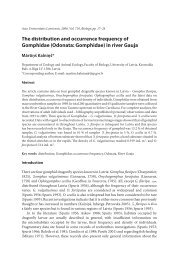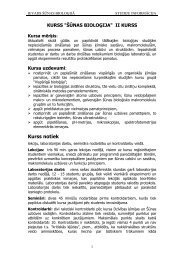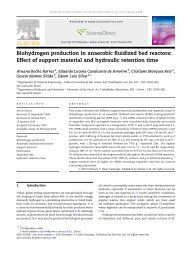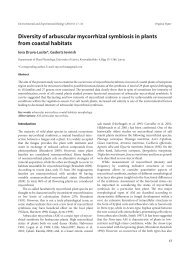Full Text (PDF) - Latvijas UniversitÄte
Full Text (PDF) - Latvijas UniversitÄte
Full Text (PDF) - Latvijas UniversitÄte
You also want an ePaper? Increase the reach of your titles
YUMPU automatically turns print PDFs into web optimized ePapers that Google loves.
Tick-borne encephalitis in Latvia 2002 - 2003 35<br />
the Vaccination service indicates some similarity. The majority of ticks here were also<br />
collected in September (in 2002 – two months earlier). The correlation between seasonal<br />
distribution of TBE cases and numbers of ticks collected from persons in 2003 was rather<br />
high: for adults the correlation coefficient was 0.91 and for nymphs – 0.92 (p < 0.05).<br />
However, in 2002 the correlation was higher and more expressed for adults, not for<br />
nymphs: for adults the correlation coefficient was 0.98 and for nymphs – 0.95 (p < 0.05)<br />
(Fig. 5). This could indicate another significant factor besides tick activity influenced<br />
the TBE morbidity level in 2003. According to the personal observations of specialists<br />
of the Latvian Nature Museum, 2003 was a year with a very good mushroom harvest in<br />
woodlands started in autumn, in contrast to that in 2002. This may have helped to promote<br />
the frequency of visits of the Latvian population to forests.<br />
Although the seasonal activity of adult questing I. ricinus registered in the tick<br />
monitoring site in the Riga region decreased in 2003 compared with the previous year,<br />
the nymph activity increased significantly especially in May and September. Similar<br />
differences were apparent from the Vaccination service data: in 2002 more than a half<br />
(55 %) of all collected ticks from patients were adults (predominantly females); while in<br />
2003 the majority was nymphs (58 %).<br />
In 2002 the mean TBEV prevalence level in questing adult ticks identified with the<br />
ELISA test method was 4.2 times lower than in ticks removed from patients. In 2003, this<br />
difference was similar (3.7 times), and a total decrease in the TBEV prevalence level had<br />
been noticed in both questing ticks and ticks removed from patients. In the same time,<br />
the number of tested ticks from patients in 2003 increased 2.6 times for adults but more<br />
significantly (4.5 times) for nymphs.<br />
The seasonal dynamics of TBEV prevalence in ticks (adults or nymphs) brought<br />
by patients to the Vaccination service did not indicate a significant correlation with the<br />
seasonal distribution of TBE cases (R = 0.11 - 0.50, p < 0.05). This suggests that the tick<br />
population dynamics may be a more important factor influencing the TBE morbidity level<br />
than TBEV prevalence in tick population.<br />
The results of the initial investigations of the TBEV virus with the direct test method<br />
Fig. 5. Correlation (r) between monthly number of TBE cases and number of ticks removed from<br />
patients in 2003 (data from the Vaccination service).














